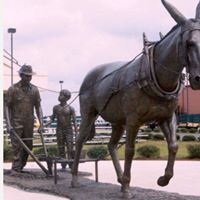In which geographical area of the United States is one of the world's largest aquifers located?
An aquifer is an underground layer of water-bearing permeable rock, rock fractures or in consolidated material such as gravel, silt or sand. Groundwater from aquifers can be extracted using a water well. The study of water flow in aquifers and the characterization of aquifers is called hydrogeology.
Although aquifers are sometimes characterized as “underground rivers or lakes,” they are actually porous rock saturated with water.
The Ogallala Aquifer is a shallow water table aquifer surrounded by sand, silt, clay and gravel located beneath a geographic area called the Great Plains in the United States. It is one of the world’s largest aquifers covering an area of approximately 174,000 square miles (450,000 km2) in portions of 8 states including South Dakota, Nebraska, Wyoming, Colorado, Kansas, Oklahoma, New Mexico, and Texas.
The aquifer was named in 1898 by geologist Nelson H. Darton (1865-1948) who worked for the United States Geological Survey. He was an expert at geological photography, a noted geologic map maker and a hydrogeologist. Darton named it from its type locality near the town of Ogallala, Nebraska. Type locality is a term to identify where particular rock type, is first identified. The term is similar to the term type site in archaeology or the term type specimen in biology.
The deposition of aquifer material dates back two to six million years.
More Info:
en.m.wikipedia.org


